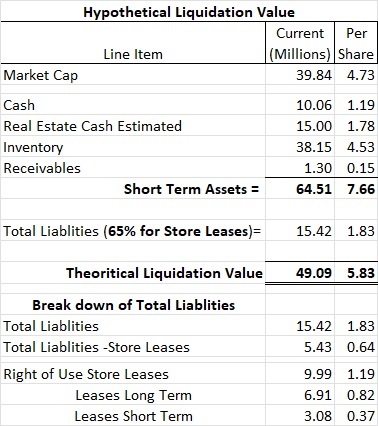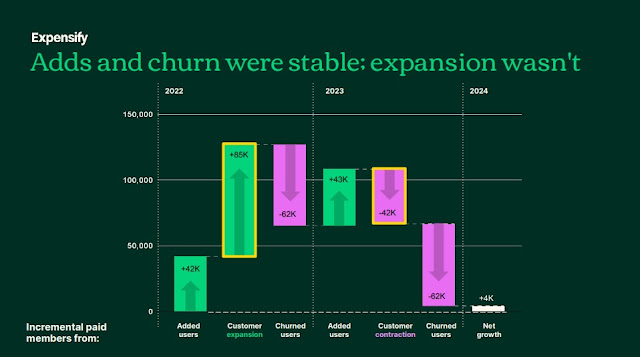Today's post updates the risks and opportunities associated with the recent real estate sale and also contains a message for the Chairman of the board.
Business Summary:
- Tandy
Leather (TLF), founded in 1919, is the profitable leader of the leather
crafting retail market.
- TLF
sells leather and leather craft-related items primarily through retail
stores, websites, or direct account representatives.
- Tandy
has 101 stores in 40 states, six provinces in Canada, and one store in
Spain.
- Several
smaller, privately family owned competitors exist, including Double Eagle
Leathersmith, Montana Leather Company, and Weaver Leather Supply.
Tandy Leather announced on Dec 6th that its corporate
headquarters was sold for $26.5 million before taxes/expenses. The expected
closing date is sometime in January 2025. As part of its transition to new
facilities in Fort Worth, Texas, Tandy will lease back the facilities until
September 2025.
The announcement had a minimal impact on TLF's stock price.
Before the announcement, the stock traded at approximately $4.20 per share over
the trailing three months. Following the sale announcement, the price rose
modestly to $4.75 per share. Given the stock’s limited trading volume, even
this increase lacked significant momentum.
This muted market reaction is surprising, especially
considering that the company’s liquidation value, by my conservative estimate,
increased by 42%. This estimate assumes $15 million in additional net cash
proceeds from the sale, based on a pre-announcement value of $35 million. My
calculation factors in estimated real estate taxes and expenses of $11.5
million, leaving $15 million in net cash proceeds.
Dear Mr. Chairman,
I have been a dedicated shareholder of Tandy for many years,
but I am increasingly concerned about the board’s operational oversight and
strategic decision-making. My concerns stem from significant missteps,
including the mishandling of inventory errors and the substantial expenditure
on consultants, which squandered shareholder value.
The current CEO is 63 years old, and two CFOs have been
hired and departed within two years. This instability raises serious questions
about the board’s ability to identify and retain competent leadership for key
positions. Why should shareholders trust the board to effectively replace a
future CEO or CFO? Furthermore, how does the board intend to responsibly
allocate proceeds from the headquarters sale, valued at $26.5 million?
Accountability for Inventory Errors
I believe the removal of former CFO Ms. Castillo following the discovery of
inventory errors in Q4 2019 was a mistake. Despite this, the board has not
taken accountability for the multi-year inventory errors or the lack of
compliant systems that led to them. As a fiduciary body, the board is
responsible for overseeing inventory management, ensuring system compliance,
and approving budgets for improvements. Yet, the company relied on outdated,
non-integrated systems—some stores even maintained paper records. These
shortcomings culminated in regulatory penalties and significant value
destruction, further eroding shareholder trust.
Financial Oversight Gaps
Since 2020, Tandy has recruited and lost two CFOs. These hires were
ill-suited for the role, as evidenced by their short tenures. This reflects a
glaring gap on the board—a lack of members with real-world corporate finance
and operational experience. This deficiency has directly contributed to ongoing
accounting irregularities. Why was Ms. Castillo removed in the first place, and
how can shareholders trust the board to effectively select a new CFO given its
track record?
Compensation Discrepancies and Shareholder Concerns
In FY 2023, Tandy, a $35 million nano-cap company, paid its CEO and a board
member $1,181,280 in total compensation. The CEO now holds 439,285 shares, or
5.22% of shares outstanding, alongside generous annual stock options—such as
92,000 shares in 2022 with an exercise price of $3.52. These figures appear
disproportionate to Tandy’s size and performance, particularly in light of the
challenges faced since the discovery of inventory errors.
Cash Balance Decline and Cost Mismanagement
When inventory errors were identified in Q4 2019, Tandy’s audited cash
balance stood at $25 million. By September 2022, when Tandy was relisted on
NASDAQ, this had plummeted to $3 million. While inventory valuation issues did
not impact cash directly, the precipitous decline reflects significant
mismanagement. Currently, the cash balance sits at $10 million. What specific
actions contributed to this erosion of cash reserves?
From 2019 to 2020, the company spent $5.5 million on
restatement efforts and CFO transitions. Over two years, an additional $4.9
million was allocated to restatements, with $594,000 earmarked for CFO-related
expenses, as disclosed in the 10-K. Despite these investments, the board failed
to ensure the implementation of effective ERP and accounting systems, leading
to ongoing inefficiencies and delays.
Relisting and Additional Costs
Tandy was delisted from NASDAQ in August 2020 after the board failed to
prepare timely financial statements. It took nearly two years—and significant
costs for financial consultants, ERP system advisors, and CFO transitions—for
the company to regain its listing in July 2022. Between 2019 and 2022, millions
of dollars were spent without clear disclosure of consultant costs, further
frustrating shareholders.
The board must address these systemic failures and
communicate a transparent plan for the future. As a shareholder, I urge you to
take immediate action to restore confidence by improving oversight, ensuring
accountability, and demonstrating a commitment to responsible financial
stewardship.
Shareholders are not unreasonable in believing the upcoming
cash infusion will evaporate. Furthermore, the proposed small dividend would do
little to offer meaningful liquidity to long-term shareholders who have
patiently supported the company for years.
Opportunities
The board must recognize that Tandy Leather Factory (TLF) is
not suited to remain a publicly listed company. However, due to inertia, the
company continues to bear unnecessary administrative and operational expenses,
which serve no real benefit to shareholders or employees. A strategic sale of
Tandy would unlock significant value and position the company for long-term
health and growth under more suitable ownership.
Tandy's future lies with an entity capable of nurturing its
potential for the benefit of all stakeholders. Based on NAV or EBITDA multiple
valuations, Tandy could command a premium of over 65% above its current market
value.
A new owner could realize over $1 million in annual savings
by eliminating public company costs, including listing fees, audits, and legal
expenses. These savings alone would contribute to immediate profitability
improvements.
Since 2018, Tandy's EBITDA margins have averaged
approximately 6.75%, generating an annual EBITDA of $5.4 million. However, for
the 17 years prior, EBITDA margins averaged a much stronger 12.6%. If a new
owner can drive modest revenue growth—boosting the current $76 million average
revenue to $80 million—and restore historical EBITDA margins to 12%, Tandy’s
annual EBITDA could reach $10 million.
This approach not only enhances operational efficiency but
also provides a sustainable foundation for growth, benefiting employees,
customers, and investors alike. The path forward is clear: a strategic sale
would unlock Tandy's true value and secure its future.
Valuation using the Balance Sheet
These metrics all point to a much higher valuation over the current 38M.
Conclusion: NOW is the time to explore strategic alternatives.
I respectfully urge the Board of Directors to engage in a
thorough review of strategic alternatives, including the potential sale of the
company, to maximize shareholder value and ensure the long-term interests of
all stakeholders are prioritized
The board must urgently develop and present a transparent
plan to ensure shareholders have the opportunity to exit at a fair and
reasonable price – no less than $7 per share. If the board cannot
achieve this without pursuing a sale of the company, then it is imperative they
explore and initiate a formal sale process without delay.
As Benjamin Graham wisely noted in Security Analysis:
"It is not the function of the corporation to make the market for its
shares, but it should provide a fair and reasonable opportunity for
stockholders who desire to dispose of their holdings to obtain an adequate
price for them."
Currently, minority shareholders are being neglected and
undervalued by Tandy’s board. This has persisted for far too long. Mr.
Chairman, it is time to demonstrate goodwill and take meaningful action to
address shareholder concerns.
Long TLF















